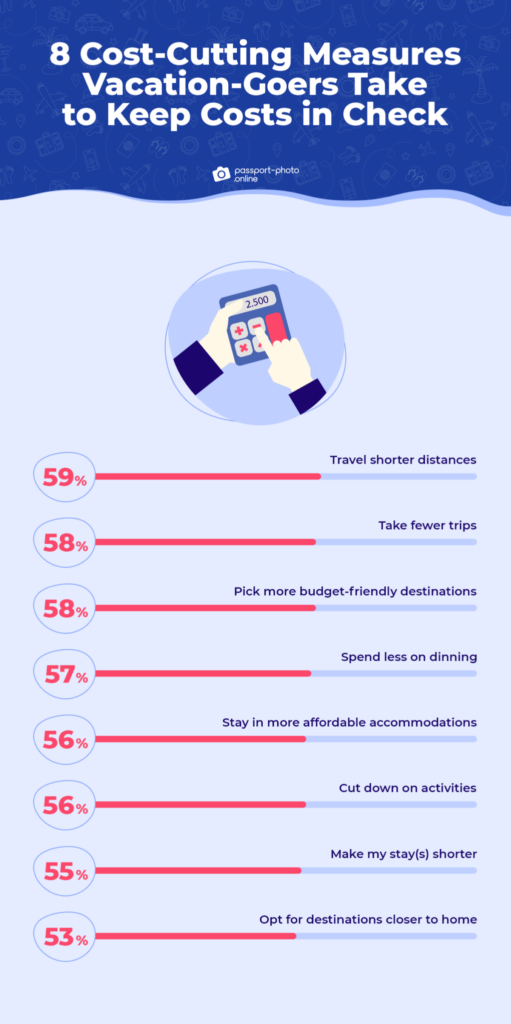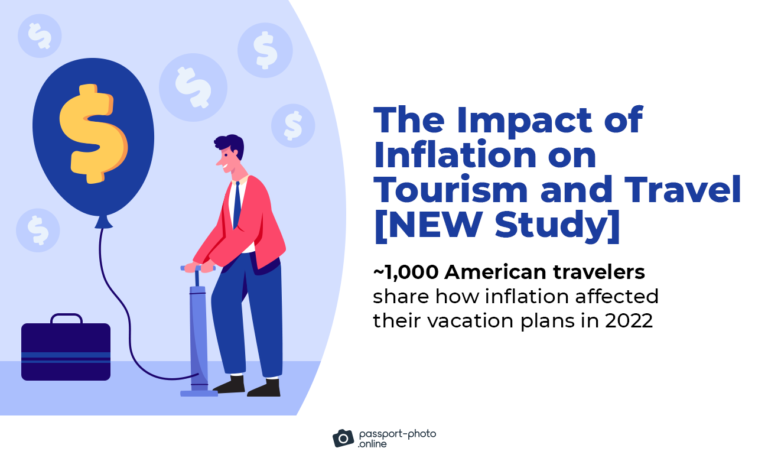
The last three years have been a difficult time for the tourism sector. Strong and unexpected hit from the COVID-19 pandemic, political unrest due to the Russian aggression toward Ukraine, and the outbreak of inflation in almost all Western countries have the strongest impact on travel and tourism businesses. Most experts from the World Tourism Organization (UNWTO) claim that the sector won’t fully recover until 2024.
Passport Photo Online has issued a survey-based study to discover how the third of the abovementioned problems – inflation – influences American travelers’ decisions on spending their vacation. Let’s take a look at the key findings.
How inflation changes travel perspectives
One crucial positive outcome is that most Americans didn’t resign from their vacation plans, even though 94% of them claim they have to budget more toward their travel time compared to 2021.
Almost three out of five respondents (59%) plan to take two or three leisure trips this year, spending between $2,001 and $3,000 per person, despite high inflation pushing prices up. The most likely explanation for this phenomenon is the hunger for travel resulting from long-lasting lockdowns caused by the pandemic.
One out of three travelers admit to increasing their vacation budget by 11-20%, and almost the same number of surveyed pointed out enlarging their spending by 21-30%.
Of course, allocating higher amounts for holidays is not the only way to deal with inflation. The other one is downgrading the cut spending across all major trip components. Nearly nine out of ten (88%) travelers admitted to decreasing their budget on things like lodging, dining, recreation, and entertainment.
Digging deeper, the survey unveiled that budget-friendly travel decisions cover:
- traveling shorter distances (59% of respondents);
- reducing the number of trips (58%);
- choosing budget-friendly destinations (58%);
- spending less on restaurants and bars (57%);
- picking more affordable B&Bs (56%);
- lowering extra activities (56%);
- shortening the length of stays (55%);
- opting for destinations closer to home (53%).
 Choosing alternative means of transportation is just another way to reduce vacation costs. Especially if we consider the rise in fuel prices impacts air travel more than car travel. In fact, even 85% of Americans claim to seek plane alternatives, namely car (75% of respondents), train (66%), bus (60%), and ship (43%).
Choosing alternative means of transportation is just another way to reduce vacation costs. Especially if we consider the rise in fuel prices impacts air travel more than car travel. In fact, even 85% of Americans claim to seek plane alternatives, namely car (75% of respondents), train (66%), bus (60%), and ship (43%).
It’s worth mentioning that 72% of surveyed travelers are likely or very likely to cut back on travel in 2022 and beyond if prices continue to rise.
Main concerns against traveling
Although Passport Photo Online’s study revealed that even 96% of American travelers plan to go on a vacation this year, other sources are not so optimistic. According to the Vacationer, it’s 81%, and NerdWallet’s report claims it can be only 70%. Therefore, it’s worth exploring the main reasons against traveling this year.
The results prove that the main concerns are external. Nearly half of the respondents indicate inflation and rising prices as the primary reasons for not being able to travel this year. The second frequently mentioned external factor is the COVID-19 pandemic, with 48% of travelers not feeling safe enough to take a trip. And even though the vaccine rollout seems to positively affect people getting back on track with their pre-pandemic plans, there’s still a long way to go.
The internal reasons for not traveling this year that were mentioned most include the following:
- family obligations (38%);
- work duties (37%);
- health problems (22%).
Let’s stop for a while and analyze the work-related issues that prevent people from traveling this year. The research found that they are mostly connected to the workload. More than a half (51%) of surveyed Americans pointed it out as a reason behind the decision not to take a vacation this year.
The second most popular answer (40%) is an external pressure not to use vacation days. That’s an alarming result as employees should feel free to use their well-deserved days off and re-charge their batteries. Almost one out of three Americans don’t have a cover at work to take a vacation, and 18% decide not to take days off because of the fear of an overwhelming workload after returning.
Conclusion
Taking into account all of the above, it’s safe to say that travelers will have to be more mindful of their spending power and make budget-friendly decisions while planning their dream vacations.
External factors such as inflation and the COVID-19 pandemic still significantly discourage people from taking trips. And even though the vaccine rollout offers some hope for the future, it will still take some time before we can say that the travel industry is back to normal.
Internal reasons such as family obligations and work duties also prevent Americans from using their vacation days. And even though most of them would love to travel, they don’t feel like they have the opportunity to do so.
Author’s bio:
Michal Jonca is a travel, food, and trail running passionate who visited 40+ countries on four continents. He is a Travel Leader for the adventurous travel company Solisci and the Community Manager at PhotoAiD.
Only this year, he enjoyed his workation in Thailand, Turkey, and the Caucasus mountains.




